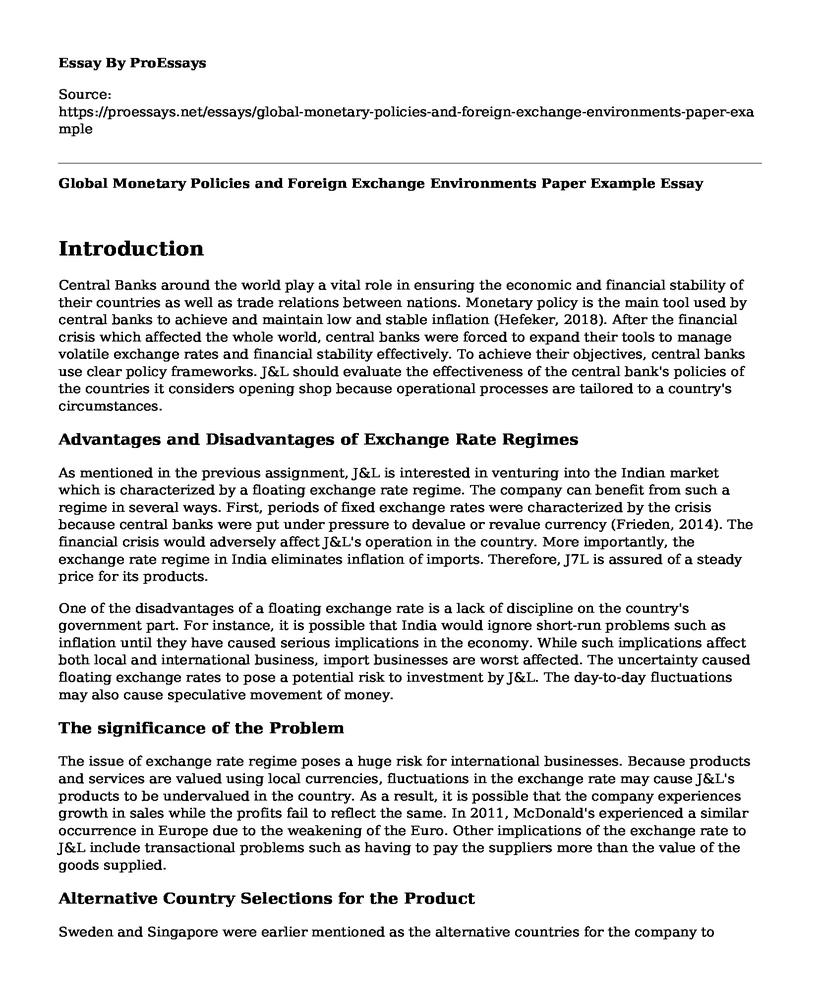Introduction
Central Banks around the world play a vital role in ensuring the economic and financial stability of their countries as well as trade relations between nations. Monetary policy is the main tool used by central banks to achieve and maintain low and stable inflation (Hefeker, 2018). After the financial crisis which affected the whole world, central banks were forced to expand their tools to manage volatile exchange rates and financial stability effectively. To achieve their objectives, central banks use clear policy frameworks. J&L should evaluate the effectiveness of the central bank's policies of the countries it considers opening shop because operational processes are tailored to a country's circumstances.
Advantages and Disadvantages of Exchange Rate Regimes
As mentioned in the previous assignment, J&L is interested in venturing into the Indian market which is characterized by a floating exchange rate regime. The company can benefit from such a regime in several ways. First, periods of fixed exchange rates were characterized by the crisis because central banks were put under pressure to devalue or revalue currency (Frieden, 2014). The financial crisis would adversely affect J&L's operation in the country. More importantly, the exchange rate regime in India eliminates inflation of imports. Therefore, J7L is assured of a steady price for its products.
One of the disadvantages of a floating exchange rate is a lack of discipline on the country's government part. For instance, it is possible that India would ignore short-run problems such as inflation until they have caused serious implications in the economy. While such implications affect both local and international business, import businesses are worst affected. The uncertainty caused floating exchange rates to pose a potential risk to investment by J&L. The day-to-day fluctuations may also cause speculative movement of money.
The significance of the Problem
The issue of exchange rate regime poses a huge risk for international businesses. Because products and services are valued using local currencies, fluctuations in the exchange rate may cause J&L's products to be undervalued in the country. As a result, it is possible that the company experiences growth in sales while the profits fail to reflect the same. In 2011, McDonald's experienced a similar occurrence in Europe due to the weakening of the Euro. Other implications of the exchange rate to J&L include transactional problems such as having to pay the suppliers more than the value of the goods supplied.
Alternative Country Selections for the Product
Sweden and Singapore were earlier mentioned as the alternative countries for the company to export its products. Sweden uses an exchange rate regime that is similar to that of India. On the other hand, Singapore uses a floating exchange rate policy which more managed by the government than the case of India and Sweden (Ghosh, Ostry, & Chamon, 2016). Because the government is involved in controlling the exchange rate, the business environment in the country is characterized by fewer uncertainties when compared to India and Sweden.
Recommended Country
Despite Singapore having a better exchange rate regime, India still stands out as the best country for the company to introduce its products. The Indian government encourages foreign direct investments by incentives such as tax cuts. Additionally, the population of the country surpasses that of Sweden and Singapore combined. This would create a huge market for J&L swinging doors. Besides, India is slowly moving from a low income to middle-income economy which creates lots of opportunity for international companies.
References
Frieden, J. A. (2014). Currency politics: The political economy of exchange rate policy. Princeton University Press. Retrieved from http://scholar.harvard.edu/files/jfrieden/files/toc_and_preface.pdf
Ghosh, A. R., Ostry, J. D., & Chamon, M. (2016). Two targets, two instruments: Monetary and exchange rate policies in emerging market economies. Journal of International Money and Finance, 60, 172-196. Retrieved from https://www.cass.city.ac.uk/__data/assets/pdf_file/0010/219970/115.-Chamon-v2.pdf
Hefeker, C. (2018). Interest groups and monetary integration: The political economy of exchange regime choice. Routledge. https://doi.org/10.1017/S0022050700021045
Cite this page
Global Monetary Policies and Foreign Exchange Environments Paper Example. (2022, Dec 22). Retrieved from https://proessays.net/essays/global-monetary-policies-and-foreign-exchange-environments-paper-example
If you are the original author of this essay and no longer wish to have it published on the ProEssays website, please click below to request its removal:
- Essay Example on the Theory of Consumers' Choice
- McKinney-Vento Act Policy Essay
- Steps That the Bid Committee Take to Plan a Successful Bid - Essay Sample
- Essay Sample on Multicultural Psychology and Counseling
- Industrialism and Capitalism From the 18th Century to 2019
- China-US Trade War: Effects of Tariffs on Economy - Research Paper
- Essay Example on Organizational Success: Culture, Leadership, and Employee Engagement







